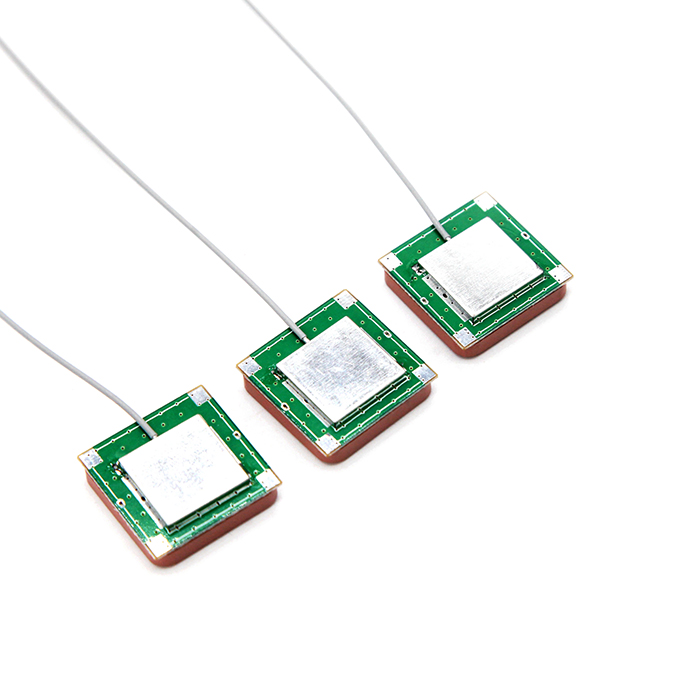- Home
- Service
- Product Center
- Application
- About Us
- Videos
- News
- Contact Us
2025-09-27 16:14:11
The GNSS Internal Antenna Ceramic Active Gps Navigation antenna is a highly specialized component designed for receiving signals from Global Navigation Satellite Systems (GNSS), including GPS (USA), GLONASS (Russia), Galileo (Europe), and BeiDou (China). Its core element is a ceramic patch radiator, typically composed of materials like barium strontium titanate, which is engineered with a high dielectric constant (εr often ranging from 20 to 40). This high permittivity allows the antenna to be miniaturized to compact dimensions, often as small as 15mm x 15mm x 4mm, while still efficiently resonating at the critical L-band frequencies used for satellite navigation (e.g., 1575.42 MHz for GPS L1, 1602 MHz for GLONASS L1). A key differentiator is its active design, which incorporates a low-noise amplifier (LNA) integrated directly into the antenna module or its feed line. This LNA provides a significant gain, typically between 25 dB to 30 dB, which is crucial for compensating signal losses in the coaxial cable and for boosting the extremely weak signals received from satellites, often as low as -130 dBm. The amplifier itself is characterized by an exceptionally low noise figure, usually below 1.5 dB, ensuring minimal degradation of the signal-to-noise ratio (SNR). Furthermore, these antennas are designed for a low voltage standing wave ratio (VSWR), ideally below 2:1 across the operational band, indicating efficient power transfer from the antenna to the receiver. The antenna's radiation pattern is typically hemispherical or quasi-hemispherical, providing a wide gain coverage of up to 160 degrees to effectively receive signals from satellites across the sky. To ensure resilience against multipath interference—signals reflected from the ground or buildings—high-quality models feature a ground plane and are optimized for a high axial ratio, making them more sensitive to the right-hand circularly polarized (RHCP) signals transmitted by satellites and less sensitive to the left-hand circularly polarized (LHCP) reflected signals.

The integration of a compact form factor, active amplification, and high performance makes this antenna type indispensable in a vast array of modern electronic devices.
Consumer Electronics: This is the most common application. Every smartphone, tablet, smartwatch, and personal fitness tracker that includes location services relies on a miniature internal antenna of this kind. Its small size allows it to be fitted into the increasingly slim and dense chassis of modern gadgets.
In-Vehicle Systems: Modern automotive navigation systems, telematics control units (TCUs) for fleet management, stolen vehicle recovery systems, and advanced driver-assistance systems (ADAS) all utilize these antennas. They are often embedded within the dashboard, roof liner, or rear windshield, providing reliable positioning for turn-by-turn navigation and safety features.
Precision Agriculture: While high-precision farming often uses more expensive survey-grade antennas, many systems for guidance, variable rate application, and asset tracking employ robust active ceramic antennas due to their reliability and cost-effectiveness.
Unmanned Aerial Vehicles (UAVs) and Drones: Drones require lightweight and compact gps antennas for flight stabilization, autonomous navigation, and return-to-home functions. The active ceramic antenna is perfectly suited for this purpose.
Wearable Devices and Asset Trackers: Pet trackers, personal locator beacons, and logistics asset tags use these antennas for their low power consumption (typically 3.3V DC) and small footprint, enabling long battery life and discreet form factors.
Internet of Things (IoT) and M2M Communication: A multitude of IoT sensors and Machine-to-Machine (M2M) modules for environmental monitoring, smart city infrastructure, and industrial automation integrate these antennas to provide location and timestamp data.
Despite being solid-state components, proper handling and care are essential to maintain the optimal performance and longevity of a GNSS internal active antenna.
Physical Protection: The ceramic radiating element is brittle and can crack under mechanical stress, such as drops or excessive pressure. A crack can severely detune the antenna, degrading its performance or rendering it useless. Devices housing the antenna should be handled with care to avoid impacts.
Avoiding Moisture and Corrosion: While many antennas are potted or coated with a protective layer to resist moisture, prolonged exposure to humid environments or direct contact with water can lead to corrosion of the solder joints and the active components. Ensuring the host device's seals are intact is crucial for applications in vehicles or outdoors.
Preventing Electrical Overload: The integrated Low-Noise Amplifier (LNA) is highly sensitive to electrostatic discharge (ESD) and voltage spikes. During installation or handling, proper ESD precautions (e.g., using a grounded wrist strap) must be taken. Furthermore, it is critical to ensure that the DC bias voltage supplied to the antenna (often via the coaxial cable) is within the specified range (e.g., 3.0V to 5.0V). Exceeding the maximum voltage can instantly destroy the amplifier.
Optimal Placement: For end-users, this means being mindful of where the device is used. The antenna performs best with a clear, unobstructed view of the sky. Metal objects, dense materials like concrete, and even the user's hand can block or reflect signals, leading to poor accuracy or a complete loss of lock. When installing a device with an internal antenna, follow manufacturer guidelines regarding placement away from large metal surfaces.
Cleaning: If cleaning the device's exterior is necessary, use a soft, slightly damp cloth. Avoid using harsh chemicals, solvents, or abrasive cleaners that could seep into the device and damage the antenna assembly or its electrical connections.
Temperature Considerations: Although designed to operate over a wide temperature range (e.g., -40°C to +85°C), extreme and prolonged heat can degrade the internal components and solder joints. Avoid leaving devices in direct sunlight for extended periods, such as on a car dashboard on a hot day.
The GNSS internal ceramic active antenna is a marvel of modern RF engineering, enabling precise positioning and navigation in a compact and efficient package. Its widespread adoption across industries underscores its critical role in the connected world. By understanding its technical principles and adhering to simple maintenance practices, users can ensure reliable performance throughout the lifespan of their navigation-enabled devices.